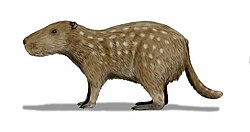| Bathyergoides Temporal range: Early Miocene ~ | |
|---|---|
| Scientific classification | |
| Domain: | Eukaryota |
| Kingdom: | Animalia |
| Phylum: | Chordata |
| Class: | Mammalia |
| Order: | Rodentia |
| Parvorder: | Phiomorpha |
| Family: | † Bathyergoididae Lavocat, 1973 |
| Genus: | † Bathyergoides Stromer 1926 [1] |
| Species | |
B. neotertiarius (type) | |
Bathyergoides is an extinct genus of rodent from Africa thought to be related to the modern blesmols. It is the only member of the family Bathyergoididae.[ citation needed ] Fossils of Bathyergoides neotertiarius were recovered from the Early Miocene Elisabeth Bay Formation of Namibia. [2]














